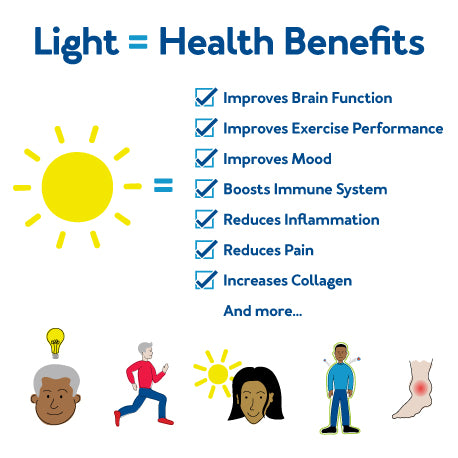
Understanding the Light Spectrum and its Benefits
Did you know various spectrums of light offer unique health benefits?
In this article, we cover the essentials of light's spectrum, including what it is, how it works, and the different light spectrums and their benefits.
Author:START READING
Did you know light can offer many benefits for different ailments and conditions?
Whether it's natural sunlight or human engineered products, the spectrum of light can be used to treat a variety of conditions such as seasonal depression, aches and pains from arthritis, fibromyalgia, and various injuries, and skin conditions such as acne, wrinkles, and more.
This guide will walk you through understanding the light spectrum, its benefits, and various types of light therapy products that can make every day easier.
What is the Spectrum of Light?
You may be wondering, "what is the light spectrum?" or "what is light spectra?" (spectra is the plural form of spectrum.).
Light spectrum (also known as electromagnetic spectrum) is a term used to describe the range of light that exists, known as light wavelength. There is visible light, which humans can see (380 to 780nm). However, most of the light in the universe is invisible to us. Light is energy and comes in many different wavelengths, known as the lightwave spectrum.
Light is measured in nanometers (nm). Each nanometer represents a wavelength of light or band of light energy. Visible light is part of the spectrum from 380nm to 780nm.
It is worth mentioning that visible light is not the only type of electromagnetic spectrum. It is the one form the eye can perceive. The invisible parts of the electromagnetic wave spectrum include:
- Infrared - this is heat produced by thermal bodies. Infrared is released by heat or thermal energy.
- UV-Light - ultraviolet (UV) is electromagnetic radiation ranging from 10 nm to 400 nm. Any type of light with a wavelength immediately shorter than visible spectrum light is considered ultraviolet light.
- X-Rays - this type of light has a high energy and short wavelength that ranges from .01 to 10 nm.
- Gamma Rays - this type of light is the highest in both frequency and energy. Gamma rays are also the most damaging to living beings.
- Cosmic Rays -
- Microwaves - this type of light is used in radar for communication and in household microwaves to warm food.
- Radar
- Radio
- Broadcast Bands

TL/DR
- The light spectrum (also called the electromagnetic spectrum) describes the existing range of light.
- Light is energy that comes in different wavelengths called the lightwave spectrum.
- Light is measured in nanometers, with visible light being in the 380 to 780nm range.
- There are multiple types of visible and invisible light on the spectrum, including Infrared, UV-Light, X-Rays, Gamma Rays, and Cosmic Rays.
What are the Colors of the Visible Light Spectrum?
Have you ever heard the term "Roy G. Biv." to describe the colors of the rainbow? Red, Orange, Yellow, Green, Blue, Indigo, and Violet are the colors visible to us. This is referred to as visible spectrum light or light color spectrum.
The light spectrum chart below references the wavelength each visible color produces. Although these colors are visible, the spectrum is continuous. There are no clear boundaries between one color and the next. Each color has a different wavelength range:
| Color | Wavelength |
|---|---|
| Red | 620-780 nm |
| Orange | 585-620 nm |
| Yellow | 570-585 nm |
| Green | 490-570 nm |
| Blue | 440-490 |
| Indigo | 420-440 nm |
| Violet | 400-420 nm |

TL/DR
- Colors of the visible light spectrum include red, orange, yellow, green, blue, indigo, and violet.
- Each color has a different wavelength range.
- The spectrum of these colors is continuous, with no clear boundaries between each.
How Light Can Help: The Light Spectrum Benefits
Light, whether it be natural or artificial, provides many health benefits. There are a variety of different light therapies that can assist in treating many various ailments.
For example, natural sunlight has been proven to boost immunity levels, improve overall wellness, and boost vitamin d levels.
On the other hand, bright light therapy (which uses the benefits of visible light) has been proven to treat Seasonal Affective Disorder (SAD) and winter blues.

Improved Mental Wellness, Sleep Quality, and Energy Levels

Bright light therapy is a treatment method used to relieve symptoms of seasonal depression, sleep disorders, low energy levels, and other light deprivation related conditions.
This type of light therapy uses either full-spectrum or blue light to trigger serotonin and melatonin production in the body. These hormones are key in mood regulation, sleep-wake cycles, and overall energy levels.
What Studies Say
A 177 patient study compared six weeks of bright light therapy to cognitive behavioral therapy (CBT-SAD) for seasonal depression and found comparable results with remission rates.
Enhanced Skin Health

Low-Level Light Therapy (also known as LLLT) is a fast-growing technology used to treat many conditions, especially for the skin. It has been studied that LLLT assists the skin by increasing collagen production and providing skin rejuvenation. LLLT has also been used for acne, wrinkle reduction, vitiligo, scarring, burns, psoriasis, and many other skin conditions.
What Studies Say
A study involving 136 volunteers found red light therapy to improve skin complexion and feeling while creating less roughness and denser collagen after 30 treatments.
Pain Relief and Injury Recovery

LLLT (also known as LED light therapy) can also be used for health conditions not related to the skin, such as muscle/joint pain, stiffness, aches, injuries, and bruising, and many more.
What Studies Say
A 39 patient study looked at the effects of red light therapy on chronic back pain. The treatment resulted in a reduced pain level from 6.9/10 to 3/10, concluding it receives pain with no adverse side effects.

Comparing Each Spectrum of Light Color
Blue light therapy, amber light therapy, and multi-spectrum light therapy have been mainly targeted to treat skin conditions pertaining to acne, wrinkles, scarring, blemishes and can even provide benefits to skin conditions such as rosacea. See our acne and wrinkle reduction light therapy products here.
Red and Infrared light therapy can provide benefits against various health conditions and have been studied and medically proven to treat them. Although infrared light is invisible to the naked eye, the light penetrates deep within the skin as your body reacts to the heat. The heat does not burn or hurt the skin and is UV-free. This type of light therapy has been studied to treat dementia, dental pain, hair loss, arthritis, tendinitis, and many other health ailments. See our selection of red and infrared pain relief products here.
Ultimately, infrared and red light therapy benefits are used to accelerate healing, provide pain relief, and reduce inflammation. If you are thinking about trying any light therapy products, we recommend always speaking to your physician before trying any new therapy treatment.
Full-Spectrum Light Therapy
Length: 380-730 nm
Penetration: Small
Uses:
- Improve energy
- Regulate sleep patterns
- Simulate sunlight
- Grow plants
- Lighting for studios and aquariums
Conditions it Treats:
- Seasonal Affective Disorder
- Circadian Rhythm Disorder
- Depression
- Anxiety
- Acne
- Psoriasis
- Cancer
- Neonatal Jaundice
- Dementia
- Jet Lag
- Shiftwork Adjustment
Blue Light Therapy
Length: 380-500 nm
Penetration: Small
Uses:
- Improve energy
- Regulate sleep patterns
- Simulate sunlight
- Electronic screens
- Improve skin health
Conditions it Treats:
- Seasonal Affective Disorder
- Circadian Rhythm Disorder
- Depression
- Anxiety
- Acne
- Psoriasis
- Cancer
- Neonatal Jaundice
- Dementia
- Jet Lag
- Shiftwork Adjustment
- Acne
- Sun Damage
- Nonmelanoma Skin Cancers
Amber Light Therapy
Length: 600-615 nm
Penetration: Medium
Uses:
- Skin enhancement
- Mood enhancement
- Boost lymphatic flow
- Increase cellular growth
- Aid in kidney and digestive functions
- Outdoor space and park lighting
- Lighting for aquariums
- Crosswalk lighting
Conditions it Treats:
- Skin redness
- Sun damage
- Rosacea
- Muscle cramps
Red & Infrared Light Therapy
Length:
Penetration: Deep
Uses:
- Pain relief
- Wound healing
- Tissue repair
- Improve sleep
- Weight loss
- Hair growth
- Wrinkle reduction
- Cellulite reduction
Conditions it Treats:
- Acne
- Sun damage
- Tendonitis
- Arthritis
- Dementia
- Oral Mucositis
- Carpal Tunnel Syndrome
- Sleep Intertia
TL/DR
- Light offers many health benefits, with each type/range having a different effect.
- Benefits include improved mental health, sleep, energy, pain relief, skin, and injury recovery.
- Bright light therapy, which used full-spectrum and blue light, is used to treat seasonal depression, sleep disorders, low energy levels, and other light deprivation related conditions
- Low-level light therapy (LLLT) uses a combination of blue, amber, red, and infrared to treat various skin conditions as well as relieve pain and enhance healing.
- Common types of light therapy include bright light therapy, blue light therapy, amber light therapy, and red & infrared light therapy.
Things to Consider When Choosing Any Light Therapy Product
There are many things to consider when purchasing a light therapy product. The list below is three recommendations to consider.

Is the Device Medically/Clinically Proven?
Choosing a product that is medically or clinically proven to treat any condition is essential. Look for products that have had thorough research and testing. Looking for FDA-Cleared devices will provide peace of mind that the product's effectiveness and safety are in good standing.
Another aspect is insurance approval, is the device FSA or HSA approved (if this applies to you)? Devices with this approval are eligible to be fully or partially covered by your insurance provider.
What Does the Product Treat?
Many different light therapy products treat different health conditions. It is vital to research understanding all the benefits for the specific light and treatment options. In some instances, some products can provide more than one benefit, such as a combination of acne treatment and wrinkle reduction.
Tip: Look at the devices wavelength that it emits. This will give you an idea of the type of light it produces to treat spcific conditions.

Functionality & Features
It is crucial to understand how light therapy products work and the feature and benefits they provide. Some key benefits to look out for could be treatment times, portability of the product, any added accessories. Reading customer reviews of their personal experience may assure the effectiveness of the product.
There are many options to consider when shopping for light therapy products. Investing in yourself is the first step to a better road to happy, healthy living!
TL/DR
- Consider a device that is cleared by the FDA and backed by research and testing.
- Be sure to consider what your needs are and what the device is designed to treat.
- Check the light range it emits (in nanometers) and research what that range of light is best for.
- Research other factors including the device's design, accessories, warranty, and customer reviews.
Light Therapy Related Resources
About the Author

Bianca Araujo-Mendez is the Director of Brand & Shopper Marketing at Compass Health Brands. She enjoys all things marketing and appreciates knowing the lives of others are enriched when using products from Compass Health Brands.
About Carex Health Brands
Carex is your one-stop shop for home medical equipment and for products that assist caregivers with providing the best possible support and care for their loved ones. Carex Health Brands has been the branded leader in in-home, self-care medical products for over 35 years. Our goal is to improve the lives of our customers by bring them quality products that bring dignity back to their lives. With our three nationally distributed brands, Carex Health Brands serves national, regional and independent food, drug and mass retailers along with wholesalers, distributors and medical dealers.





